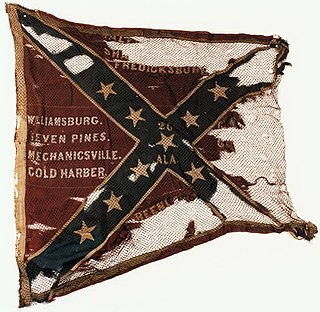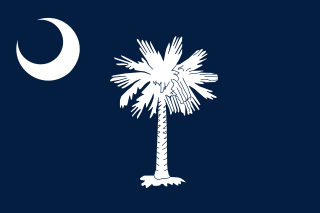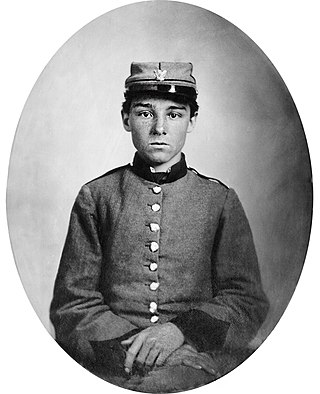The Stonewall Brigade of the Confederate Army during the American Civil War, was a famous combat unit in United States military history. It was trained and first led by General Thomas J. "Stonewall" Jackson, a professor from Virginia Military Institute (VMI). His severe training program and ascetic standards of military discipline turned enthusiastic but raw recruits into an effective military organization, which distinguished itself from the First Battle of Bull Run in 1861 to Spotsylvania Court House in 1864. Its legacy lives on in the 116th Infantry Brigade, which bears the unofficial nickname "Stonewall Brigade," and in several living history reenactment groups.

William Barksdale was an American lawyer, newspaper editor, US Representative, and Confederate general in the American Civil War. He served four terms in the U.S. House of Representatives from 1853 to 1861.
The 141st Regiment Pennsylvania Volunteer Infantry was a volunteer infantry regiment that fought in the Union Army during the American Civil War. The regiment served in the Army of the Potomac in the Eastern Theater and was heavily engaged in the second day of fighting at the Peach Orchard outside of Gettysburg.

The 2nd Virginia Infantry Regiment was an infantry regiment raised in today's western Virginia and what became West Virginia during the American Civil War for service in the Confederate States Army. It would combine with the 4th, 5th, 27th, and 33rd Virginia infantry regiments and the Rockbridge Artillery Battery and fight as part of what became known as the Stonewall Brigade, mostly with the Army of Northern Virginia.

The 24th Virginia Infantry Regiment was an infantry regiment raised in southwestern Virginia for service in the Confederate States Army during the American Civil War. It fought throughout the conflict, mostly with the Army of Northern Virginia. The 24th Virginia's most prominent field officers were Colonels Jubal A. Early and William R. Terry; Lieutenant Colonels Peter Hairston, Jr. and Richard L. Maury; and Majors William W. Bentley, Joseph A. Hambrick, and J.P. Hammet.

The 1st Virginia Cavalry Regiment was a cavalry regiment raised in Virginia for service in the Confederate States Army during the American Civil War. It fought mostly with the Army of Northern Virginia.
The 21st Regiment, Mississippi Infantry was a Confederate infantry regiment from Mississippi in the American Civil War. The regiment was involved in several well-known battles including the battles of Antietam, Chancellorsville, Gettysburg and Chickamauga.

Also known as Law’s Brigade, the Alabama Brigade was a military formation of the Confederate States Army during the American Civil War. It was created in 1863 and participated in major combat operations such as the Battle of Gettysburg, the Battle of Chickamauga, the Battle of the Wilderness and the Richmond-Petersburg Campaign. It was considered one of the great fighting brigades of the Army of Northern Virginia.
The 5th Mississippi Infantry Regiment was a regiment of infantry in the Confederate States Army during the American Civil War. The 5th Regiment was composed of volunteer companies from central Mississippi and assembled in the fall of 1861 by Colonel Albert E. Fant. After taking heavy casualties in battles in Georgia and Tennessee, the regiment surrendered in April 1865.
The 19th Mississippi Infantry Regiment an infantry formation of the Confederate States Army during the American Civil War. As part of the Army of Northern Virginia, the 19th Regiment fought in numerous battles of the Eastern Theater. The Regiment was successively commanded by Colonels Christopher Mott, Lucius Lamar, Nathaniel Harris, Thomas Hardin, and Richard Phipps.

The 26th Alabama Infantry Regiment was an infantry regiment of the Confederate States Army regiment during the American Civil War. The regiment was composed of ten companies that came from various counties across Alabama. It is one of the few regiments that served both in the Army of Northern Virginia and Army of Tennessee.

The 2nd South Carolina Infantry Regiment, also known as 2nd Palmetto Regiment, was a Confederate States Army regiment in the American Civil War.

The 2nd Louisiana Infantry Regiment was a unit of volunteers recruited in Louisiana that fought in the Confederate States Army during the American Civil War. Formed in May 1861, the regiment was sent to fight in the Eastern Theater of the American Civil War. Its first action took place during the Siege of Yorktown. The regiment suffered very heavy losses at Malvern Hill. After joining an all-Louisiana brigade, it fought at Cedar Mountain, Second Bull Run, Antietam, and Fredericksburg in 1862, at Chancellorsville, Second Winchester, Gettysburg, and Mine Run in 1863, and at the Wilderness, Spotsylvania, Cold Harbor, Monocacy, Third Winchester, Fisher's Hill, Cedar Creek, and Petersburg in 1864, and at Appomattox in 1865. The regiment lost over 100 men at both Second Bull Run and Chancellorsville. A company-sized remnant surrendered at Appomattox.

The Louisiana Guard Battery was an artillery unit recruited from volunteers in Louisiana that fought in the Confederate States Army during the American Civil War. Formed from an infantry company sent to fight in the Eastern Theater of the American Civil War, it was converted to an artillery company in July 1861. The battery fought at Cedar Mountain, Second Bull Run, Antietam, and Fredericksburg in 1862, and at Chancellorsville, Second Winchester, and Gettysburg in 1863. Most of the soldiers and all of the battery's guns were captured at Rappahannock Station on 7 November 1863. The surviving gunners manned heavy artillery pieces in the defenses of Richmond, Virginia, and the battery's remnant surrendered at Appomattox.

The 8th Louisiana Infantry Regiment was a unit of volunteers recruited in Louisiana that fought in the Confederate States Army during the American Civil War. Formed in June 1861, the regiment was sent to fight in the Eastern Theater of the American Civil War. Joining a brigade of Louisiana regiments, it fought in Jackson's Valley campaign and at Gaines' Mill, Malvern Hill, Second Bull Run, Antietam, and Fredericksburg in 1862. The regiment served at Chancellorsville, Second Winchester, Gettysburg in 1863. At Rappahannock Station in November 1863, most of the regiment was captured. The unit fought at the Wilderness, Spotsylvania, Cold Harbor, and the Valley campaigns of 1864. It served at Petersburg starting in December 1864 and surrendered at Appomattox in April 1865.
The 16th Mississippi Infantry Regiment was a unit of the Confederate States Army from southern Mississippi that participated in the Eastern theater of the American Civil War as part of the Army of Northern Virginia. The 16th Regiment fought in numerous battles, taking heavy casualties at Antietam and Spotsylvania Court House before surrendering after Union troops broke through the defenses of Petersburg, Virginia, on April 2, 1865.
The 12th Mississippi Infantry Regiment was a Confederate infantry regiment from Mississippi. As part of the Army of Northern Virginia, the 12th Mississippi fought in many battles of the Eastern theater of the American Civil War before surrendering in April 1865.
The 36th Mississippi Infantry Regiment was an infantry unit of the Confederate States Army. Formed in 1862, mostly of men from Copiah County, Mississippi, the 36th Regiment fought in many battles of the Western Theater of the American Civil War before being captured at Fort Blakely, Alabama in the closing days of the conflict.
The 14th Mississippi Infantry Regiment was a unit of the Confederate States Army from Mississippi. After fighting in numerous battles of the Western theater of the American Civil War, the Regiment surrendered in April, 1865, in North Carolina.
The 17th Mississippi Infantry Regiment was a unit of the Confederate States Army from Mississippi. As part of the Army of Northern Virginia, the 17th Mississippi fought in many of the bloodiest and most decisive battles of the Eastern theater of the American Civil War. After suffering heavy losses in battle, the remnants of the 17th Mississippi Infantry surrendered with Robert E. Lee's forces at Appomattox Court House on April 9, 1865.








